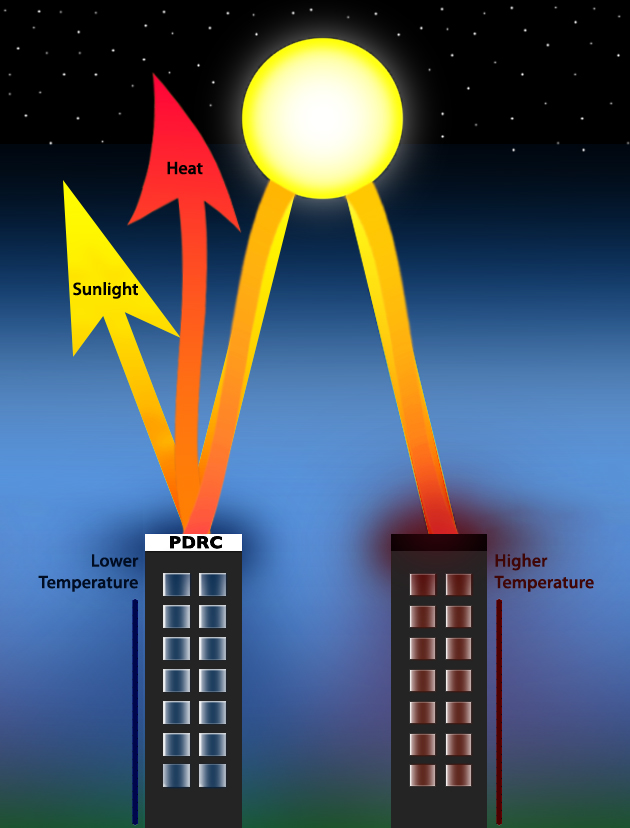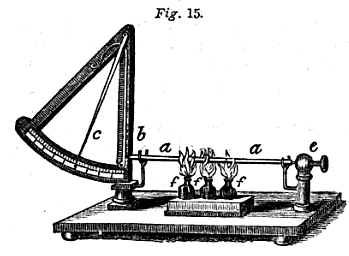|
Emissivity
The emissivity of the surface of a material is its effectiveness in emitting energy as thermal radiation. Thermal radiation is electromagnetic radiation that most commonly includes both visible radiation (light) and infrared radiation, which is not visible to human eyes. A portion of the thermal radiation from very hot objects (see photograph) is easily visible to the eye. The emissivity of a surface depends on its chemical composition and geometrical structure. Quantitatively, it is the ratio of the thermal radiation from a surface to the radiation from an ideal black surface at the same temperature as given by the Stefan–Boltzmann law. The ratio varies from 0 to 1. The surface of a perfect black body (with an emissivity of 1) emits thermal radiation at the rate of approximately 448 watts per square metre at room temperature (, ). All real objects have emissivities less than 1.0, and emit radiation at correspondingly lower rates. Emissivities are important in several conte ... [...More Info...] [...Related Items...] OR: [Wikipedia] [Google] [Baidu] |
Passive Daytime Radiative Cooling
Passive daytime radiative cooling (PDRC) is a renewable cooling method proposed as a solution to global warming of enhancing terrestrial heat flow to outer space through the installation of thermally-emissive surfaces on Earth that require zero energy consumption or pollution. Because all materials in nature absorb more heat during the day than at night, PDRC surfaces are designed to be high in solar reflectance (to minimize heat gain) and strong in longwave infrared (LWIR) thermal radiation heat transfer through the atmosphere's infrared window (8–13 µm) to cool temperatures during the daytime. It is also referred to as passive radiative cooling (PRC), daytime passive radiative cooling (DPRC), radiative sky cooling (RSC), photonic radiative cooling, and terrestrial radiative cooling. PDRC differs from solar radiation management because it increases radiative heat emission rather than merely reflecting the absorption of solar radiation. Some estimates propose that if 1–2% ... [...More Info...] [...Related Items...] OR: [Wikipedia] [Google] [Baidu] |
Thermography
Infrared thermography (IRT), thermal video and/or thermal imaging, is a process where a Thermographic camera, thermal camera captures and creates an image of an object by using infrared radiation emitted from the object in a process, which are examples of infrared imaging science. Thermographic cameras usually detect electromagnetic radiation, radiation in the long-infrared range of the electromagnetic spectrum (roughly 9,000–14,000 nanometers or 9–14 μm) and produce images of that radiation, called thermograms. Since infrared radiation is emitted by all objects with a temperature above absolute zero according to the black body Planck's law of black-body radiation, radiation law, thermography makes it possible to see one's environment with or without optical spectrum, visible illumination. The amount of radiation emitted by an object increases with temperature; therefore, thermography allows one to see variations in temperature. When viewed through a thermal imaging camera, ... [...More Info...] [...Related Items...] OR: [Wikipedia] [Google] [Baidu] |
Low-emissivity
Low emissivity (low ''e'' or low thermal emissivity) refers to a surface condition that emits low levels of radiant thermal (heat) energy. All materials absorb, reflect, and emit radiant energy according to Planck's law but here, the primary concern is a special wavelength interval of radiant energy, namely thermal radiation of materials. In common use, especially building applications, the temperature range of approximately -40 to +80 degrees Celsius is the focus, but in aerospace and industrial process engineering, much broader ranges are of practical concern. Definition Emissivity is the value given to materials based on the ratio of heat emitted compared to a perfect black body, on a scale from zero to one. A black body would have an emissivity of 1 and a perfect reflector would have a value of 0. Kirchhoff's law of thermal radiation states that absorption equals emissivity opaque for every specific wavelength/frequency (materials often have quite different emissivities a ... [...More Info...] [...Related Items...] OR: [Wikipedia] [Google] [Baidu] |
Thermal Radiation
Thermal radiation is electromagnetic radiation generated by the thermal motion of particles in matter. Thermal radiation is generated when heat from the movement of charges in the material (electrons and protons in common forms of matter) is converted to electromagnetic radiation. All matter with a temperature greater than absolute zero emits thermal radiation. At room temperature, most of the emission is in the infrared (IR) spectrum. Particle motion results in charge-acceleration or dipole oscillation which produces electromagnetic radiation. Infrared radiation emitted by animals (detectable with an infrared camera) and cosmic microwave background radiation are examples of thermal radiation. If a radiation object meets the physical characteristics of a black body in thermodynamic equilibrium, the radiation is called blackbody radiation. Planck's law describes the spectrum of blackbody radiation, which depends solely on the object's temperature. Wien's displacement law de ... [...More Info...] [...Related Items...] OR: [Wikipedia] [Google] [Baidu] |
Radiative Cooling
In the study of heat transfer, radiative cooling is the process by which a body loses heat by thermal radiation. As Planck's law describes, every physical body spontaneously and continuously emits electromagnetic radiation. Radiative cooling has been applied in various contexts throughout human history, including ice making in India and Iran, heat shields for spacecrafts, and in architecture. In 2014, a scientific breakthrough in the use of photonic metamaterials made daytime radiative cooling possible. It has since been proposed as a strategy to mitigate local and global warming caused by greenhouse gas emissions known as passive daytime radiative cooling. Terrestrial radiative cooling Mechanism Infrared radiation can pass through dry, clear air in the wavelength range of 8–13 µm. Materials that can absorb energy and radiate it in those wavelengths exhibit a strong cooling effect. Materials that can also reflect 95% or more of sunlight in the 200 nanometres to 2. ... [...More Info...] [...Related Items...] OR: [Wikipedia] [Google] [Baidu] |
Pyrometer
A pyrometer is a type of remote-sensing thermometer used to measure the temperature of distant objects. Various forms of pyrometers have historically existed. In the modern usage, it is a device that from a distance determines the temperature of a surface from the amount of the thermal radiation it emits, a process known as pyrometry and sometimes radiometry. The word pyrometer comes from the Greek word for fire, "πῦρ" (''pyr''), and ''meter'', meaning to measure. The word pyrometer was originally coined to denote a device capable of measuring the temperature of an object by its incandescence, visible light emitted by a body which is at least red-hot. Modern pyrometers or infrared thermometers also measure the temperature of cooler objects, down to room temperature, by detecting their infrared radiation flux. Principle It is based on the principle that the intensity of light received by the observer depends upon distance of observer from source and temperature of dis ... [...More Info...] [...Related Items...] OR: [Wikipedia] [Google] [Baidu] |
Leslie's Cube
Leslie's cube is a device used in the measurement or demonstration of the variations in thermal radiation emitted from different surfaces at the same temperature. Device It was devised in 1804 by John Leslie (1766–1832), a Scottish mathematician and physicist. In the version of the experiment described by John Tyndall in the late 1800s, one of the cube's vertical sides is coated with a layer of gold, another with a layer of silver, a third with a layer of copper, while the fourth side is coated with a varnish of isinglass. The cube is made from a solid block of metal with a central cavity. In use, the cavity was filled with hot water; the entire cube has essentially the same temperature as the water. The thermal detector (on the far right in the figure) showed much greater emission from the side with varnish than from any of the other three sides. In contemporary terms, the emissivities of shiny metals are low. Isinglass is an organic glue, and has a much larger emissivity th ... [...More Info...] [...Related Items...] OR: [Wikipedia] [Google] [Baidu] |
International Organization For Standardization
The International Organization for Standardization (ISO ) is an international standard development organization composed of representatives from the national standards organizations of member countries. Membership requirements are given in Article 3 of the ISO Statutes. ISO was founded on 23 February 1947, and (as of November 2022) it has published over 24,500 international standards covering almost all aspects of technology and manufacturing. It has 809 Technical committees and sub committees to take care of standards development. The organization develops and publishes standardization in all technical and nontechnical fields other than electrical and electronic engineering, which is handled by the IEC.Editors of Encyclopedia Britannica. 3 June 2021.International Organization for Standardization" ''Encyclopedia Britannica''. Retrieved 2022-04-26. It is headquartered in Geneva, Switzerland, and works in 167 countries . The three official languages of the ISO are English, Fren ... [...More Info...] [...Related Items...] OR: [Wikipedia] [Google] [Baidu] |
Radiant Exitance
In radiometry, radiant exitance or radiant emittance is the radiant flux emitted by a surface per unit area, whereas spectral exitance or spectral emittance is the radiant exitance of a surface per unit frequency or wavelength, depending on whether the spectrum is taken as a function of frequency or of wavelength. This is the emitted component of radiosity. The SI unit of radiant exitance is the watt per square metre (), while that of spectral exitance in frequency is the watt per square metre per hertz (W·m−2·Hz−1) and that of spectral exitance in wavelength is the watt per square metre per metre (W·m−3)—commonly the watt per square metre per nanometre (). The CGS unit erg per square centimeter per second () is often used in astronomy. Radiant exitance is often called "intensity" in branches of physics other than radiometry, but in radiometry this usage leads to confusion with radiant intensity. Mathematical definitions Radiant exitance Radiant exitance of a ''surface' ... [...More Info...] [...Related Items...] OR: [Wikipedia] [Google] [Baidu] |
Radiance
In radiometry, radiance is the radiant flux emitted, reflected, transmitted or received by a given surface, per unit solid angle per unit projected area. Radiance is used to characterize diffuse emission and reflection of electromagnetic radiation, and to quantify emission of neutrinos and other particles. The SI unit of radiance is the watt per steradian per square metre (). It is a ''directional'' quantity: the radiance of a surface depends on the direction from which it is being observed. The related quantity spectral radiance is the radiance of a surface per unit frequency or wavelength, depending on whether the spectrum is taken as a function of frequency or of wavelength. Historically, radiance was called "intensity" and spectral radiance was called "specific intensity". Many fields still use this nomenclature. It is especially dominant in heat transfer, astrophysics and astronomy. "Intensity" has many other meanings in physics, with the most common being power per unit ar ... [...More Info...] [...Related Items...] OR: [Wikipedia] [Google] [Baidu] |
American Chemical Society
The American Chemical Society (ACS) is a scientific society based in the United States that supports scientific inquiry in the field of chemistry. Founded in 1876 at New York University, the ACS currently has more than 155,000 members at all degree levels and in all fields of chemistry, chemical engineering, and related fields. It is one of the world's largest scientific societies by membership. The ACS is a 501(c) organization, 501(c)(3) non-profit organization and holds a congressional charter under Title 36 of the United States Code. Its headquarters are located in Washington, D.C., and it has a large concentration of staff in Columbus, Ohio. The ACS is a leading source of scientific information through its peer-reviewed scientific journals, national conferences, and the Chemical Abstracts Service. Its publications division produces over 60 Scientific journal, scholarly journals including the prestigious ''Journal of the American Chemical Society'', as well as the weekly tra ... [...More Info...] [...Related Items...] OR: [Wikipedia] [Google] [Baidu] |






